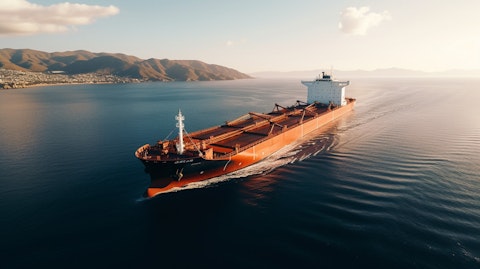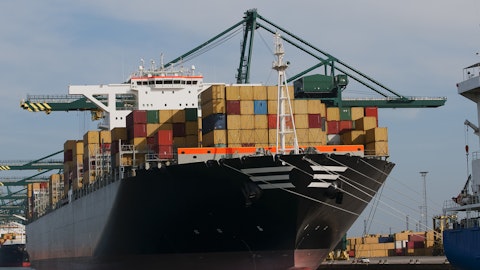Golden Ocean Group Limited (NASDAQ:GOGL) Q3 2023 Earnings Call Transcript November 21, 2023
Lars-Christian Svensen: Hi, there. And a very good afternoon from Oslo. My name is Lars-Christian Svensen and I am the Interim CEO of Golden Ocean. Today CFO, Peder Simonsen and I will guide you through our Q3 numbers and update you on recent activities in Golden Ocean and our forward outlook. Here are highlights for Q3. Our adjusted EBITDA in the third quarter of 2023 ended up at $78.9 million compared to $80.4 million in the second quarter. We delivered a net profit of $28.7 million and earnings per share of $0.14. This compared with net profit of $34.9 million and earnings per share of $0.17 for the second quarter. Our TCE rates for Capesize and Panamax vessels were $18,200 per day and $15,400 per day, respectively. Combined, a total fleet-wide net TCE of $17,100.
For Q4, we have secured a net TCE of $23,045 per day for 79% of the Capesize days and $17,250 per day for 83% of the Panamax days. For Q1, we have secured a net TCE of $21,700 per day for 12% of the Capesize days and $15,600 per day for 23% of the Panamax days. During Q3, we have also entered into back-to-back agreements to buy and sell the Supramax vessel, which we held as a purchase option. The company expects to recognize the gain from the sale of approximately $6 million upon delivery of the vessel and expected delivery date is before year-end. We also completed the sale and delivery of one of our Panamax vessels to new owners, recognizing a gain from the sale of about $1 million and net cash proceeds of about $7 million. True to the dividend policy, we declared a dividend of $0.10 per share for the third quarter of 2023.

With that, I will pass the word over to Peder.
Peder Simonsen: Thank you, Lars-Christian. If we move to the – our profit and loss, we delivered a strong commercial performance with Cape TCE rates coming in at $18,200, slightly down from the previous quarter and Panamax is coming in at $15,400 in line with previous quarter Our total fleet-wide time charter equivalent was $17,100, which was materially unchanged from Q2. We had two ships drydocked in Q3 versus fixed ships in Q2, resulting in approximately 115 days off-hire versus 215 days off-hire in Q2. We have two ships expected to drydocked in Q4, which are expected to complete – be complete by the second half of the quarter. We added just below 550 vessel days compared to Q2 through our new ship deliveries, net of vessel sales in Q3.
Our net revenues came in at $156.6 million compared to $154 million in Q2. Looking at our operating expenses, we recorded $64.5 million versus $62.4 million in the previous quarter. This was impacted by additional ship days compared to the previous quarter. In addition, we recorded approximately $3 million expense, relating to the change of technical managers on certain of our ships. This was offset by few dry dockings in this quarter compared to previous quarter and also offset by lower OpEx reclassified from charter hire with fewer ships being chartered-in on average during the quarter. The reclassified charter hire was $4.9 million in Q3 versus $6.2 million in Q2. Our general and administrative expenses came in at $4.4 million, down from $5.2 million in Q2, which is fairly unchanged, when adjusting for non-recurring items in Q2.
See also Healthiest Food in the World: Top 20 Countries with the Healthiest Diets and 12 Countries Have Aircraft Carriers But Only One Has A $13.3 Billion Warship.
Q&A Session
Follow Golden Ocean Group Ltd (NASDAQ:GOGL)
Follow Golden Ocean Group Ltd (NASDAQ:GOGL)
Our daily G&A ended at $470 per day, net of cost we charge to affiliated companies, down from $560 per day in Q2. Our charter hire expenses were $8.3 million, down from $10.2 million due to fewer vessel days in the trading portfolio and an adjusted EBITDA of $78.9 versus $80.4 in Q2. Looking at the net financial expenses, we recorded $28 million in net interest expense versus $23 million in Q2, a change due to higher reference rates and higher average debt in the quarter. The increase in interest rates also needs to be seen in relation to the realized portion of the interest rate swap portfolio, which impacted our derivatives and other financial income in the quarter. We recorded a gain of $11.9 million compared to a gain of $14.3 million, of which $10.6 million relates to interest rate swaps and $1.8 million related to bunker derivatives and FFA gains, and of the $10.6 million, $4.9 million is realized cash gains and $5.8 million is mark-to-market gains following an increase in long-term interest rates.
Results from investments in associates, we recorded a loss of $300,000 compared to a gain of $4.9 million in Q2, which relates to our investments in Swiss Marine, TFG, and UFC. A net profit of $28.7 million and $0.14 per share, and a dividend declared of $0.10 for the quarter. Moving to the next slide, our cash flow from operations came in at $47.4 million, which includes $600,000 dividend from associated companies. Our cash flow provided from financing came in at $33.5 million. We recorded $32.4 million drawdown relating to delivery of one Newcastlemax vessel. We drew $40 million relating to deliveries of two Kamsarmax newbuildings and we drew $25 million under our revolving credit facility. This was offset by $7.6 million prepayment relating to the sale of one Panamax vessel and $35.8 million in scheduled debt and lease repayments.
We recorded a dividend payment of $19.9 million relating to our Q2 results and $900,000 payment for share repurchase. Our cash flow used in investments was $88.5 million, which mainly relates to $45.3 million relating to the delivery of the last Newcastlemax vessel, $58.1 million in installments and costs relating to our Kamsarmax newbuildings, and this was offset by $14.8 million in net proceeds from the sale of the Panamax vessel. Total net decrease in cash of $7.8 million during Q3. Moving to the balance sheet, we had a cash and cash equivalents of $99.7 million, including $2.2 million of restricted cash at the end of Q3. In addition, we had $50 million in undrawn available credit facilities at quarter end. Our debt and lease liabilities totaled $1.5 billion end of Q3, up by approximately $72 million since Q2.
Our average fleet-wide loan to value under the company’s debt facilities per quarter end was 45.6% with the book equity of $1.9 billion, we had a ratio of equity to total assets of approximately 53% at the end of Q3. With that, I give the word back to Lars-Christian.
Lars-Christian Svensen: Thank you, Peder. In Golden Ocean, we like to focus on the larger vessels, where we have the most volatility and also potential upside historically. Our young and modern fleet, which currently holds an average of seven years, allows us to constantly beat the market over time and with our current vessel count on 95, we offer a large commercial platform. Our market cap of $1.5 billion and dual listings in New York and Oslo, provide solid liquidity for our shareholders. All of the above should make Golden Ocean an attractive go-to company for all investors wanting dry bulk exposure. As I mentioned in our previous slide, we’re proud of a young and modern fleet. However, it’s just as important to maintain a low cash breakeven to float in practically any market illustrated here with our 60 Capesize vessels are Cape and Newcastlemax cash breakeven over our entire fleet holds at $14,800 per day.
Due to our fleet composition and clinical execution, we have outperformed the market with about $5,000 per day so far this year. If you deduct that premium from the $14,800, Golden Ocean’s adjusted cash breakeven is below $10,000 per day. From the bottom left historical graph, you can clearly see the Golden Ocean modern fleet combined with an industry-low cash breakeven, much due to excellent financing will make money in almost any market. We will continue to invest in our vessels to increase our fleet premium towards the market and thus decrease our adjusted cash breakeven further. Not only, should we be considered a market-leading company with high liquidity, but a company that has a massive upside potential with downside protection well covered.
Albeit volatile, Q3 finished on a strong note for both Panamax and Capesize. China is continuing to import iron ore, bauxite, coal, and agri products surpassing last year’s levels. Even so, the Chinese iron ore and steel stockpiles are decreasing, much due to a huge steel export program. We have seen increased tonne miles in both segments. And with the seasonality coming to life, the Panamax and Cape sectors look to finish 2023 on a strong note. The iron ore trade has come into full bloom so far in 2023, with steady Chinese demand and continuous imports from both Brazil and Australia. Brazil will for the first time since to Brumadinho incident delivered around her yearly targets. The commodity price itself is pushing $130 per tonne, which has led to frustration in the Chinese government and steel mills as their stockpiles continue to diminish.



